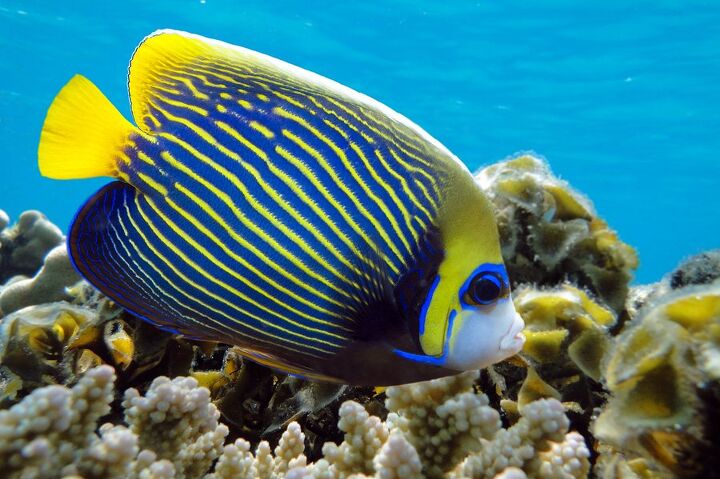Marine Angelfish


About Marine Angelfish
Also known as marine angelfish, saltwater angelfish are found primarily in tropical waters and shallow reefs. Most species are found in the Western Pacific Ocean, though a few can be found in the Atlantic and the Eastern Pacific/Indian Oceans. All marine angelfish belong to the family Pomacanthidae but there are nine different genera, including the following:
- Apolemichthys
- Centropyge
- Chaetodontoplus
- Genicanthus
- Holacanthus
- Paracentropyge
- Pomacanthus
- Pygoplites
- Sumireyakko
Different saltwater angelfish species exhibit different temperaments but most of them are fairly peaceful while young, though they tend to develop a territorial streak as they mature. Marine angelfish range in size from as small as 4 inches to as large as 24 inches. Some angelfish can get along with non-aggressive species of similar size like butterflyfish, gobies, blennies, tangs, triggerfish, and anthias.
Also known as marine angelfish, saltwater angelfish are found primarily in tropical waters and shallow reefs.
Marine angelfish can be found throughout the shallow reefs and tropical regions of the Indian, Atlantic, and Western Pacific Oceans.
Marine angelfish are known for their laterally compressed bodies and their bright colorations. These fish come in an endless array of color combinations including various shades of green, blue, yellow, purple, pink, orange, brown, black, gray, and white. Many angelfish species exhibit stripes, spots, or bars, often with colored fins.
Most saltwater angelfish are hardy in the home aquarium but it can be difficult to acclimate them to life in captivity if they were wild-caught. It is also important to note that adult angelfish can be very destructive to reef habitats so you may want to limit decorations to live rock rather than corals and other delicate invertebrates. As for the water conditions angelfish prefer, a slightly alkaline pH range between 8.1 and 8.4 is ideal with moderate hardness between 8 and 12 dKH.
Marine angelfish are known for their laterally compressed bodies and their bright colorations.
Most saltwater angelfish feed primarily on sponges and tunicates – this is what makes them difficult to keep in the home aquarium. Some species feed on plankton or algae. In the home aquarium, it is best to feed angelfish a wide variety of foods to entice them to eat.
Also read: 6 Popular Aquarium Fish You Need To Avoid
Most angelfish change drastically in color as they approach sexual maturity. Juveniles and females of different species tend to have more drab coloration while males are brightly colored. It is also interesting to note that it is possible for female angelfish to turn into a male if the dominant male from a harem is removed. Angelfish are pelagic spawners, releasing large quantities of buoyant eggs into the water which then float with the currents until hatching.
There are approximately 87 species of saltwater angelfish divided among 9 genera and not all of them are popular in the aquarium hobby. Some of the most popular species of marine angelfish for the aquarium trade include the following:
- Flame Angelfish (Centropyge loricula)
- Blue-Striped Angelfish (Chaetodontoplus septenrionalis)
- Keyhole Angelfish (Centropyge tibicen)
- Lamarck’s Angelfish (Genicanthus Lamarck)
- Queen Angelfish (Holacanthus ciliaris)
- Emperor Angelfish (Pomacanthus imperator)
- Blue Angelfish (Holacanthus bermudensis)
- Regal Angelfish (Pygoplites diacanthus)
- French Angelfish (Pomacanthus paru)
Photo credit: Mikhail Levit/Bigstock; mirecca/Bigstock

Kate Barrington is the loving owner of two cats (Bagel and Munchkin) and a noisy herd of guinea pigs. Having grown up with golden retrievers, Kate has a great deal of experience with dogs but labels herself a lover of all pets. Having received a Bachelor's degree in English, Kate has combined her love for pets and her passion for writing to create her own freelance writing business, specializing in the pet niche.
More by Kate Barrington
























